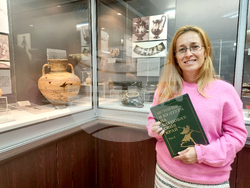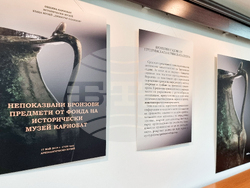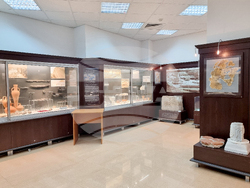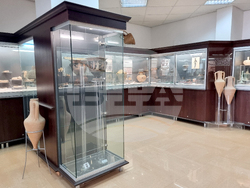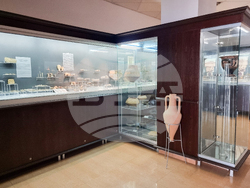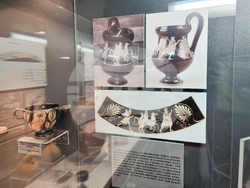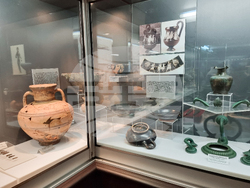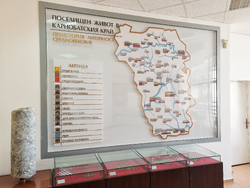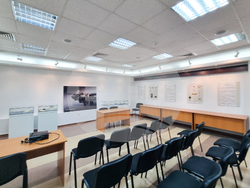site.btaHistory Museum in Karnobat to Show Unique Jug Depicting Thracian Warriors in US Getty Museum


The History Museum of Karnobat will present its most valuable artefact - a red-figure jug with the image of Thracian warriors from the 5th century BC - at the exhibition Ancient Thrace and the Classical World: Treasures from Bulgaria, Romania, and Greece, which will be unveiled at the Getty Museum in Los Angeles on November 3. Participating are 14 museums from Bulgaria with more than 150 artefacts.
The red-figure jug was discovered in 1996 after the police caught the tomb robbers who had compromised a grave in the Gyaur Mound, Dr. Rositsa Hristova, Director of the Atanas Karastoyanov History Museum in Karnobat, told BTA's Maya Stefanova. It is the most significant and valuable find in the archaeological exposition of the Atanas Karastoyanov History Museum in Karnobat. "We do not have any other artefact that arouses such interest and has such popularity. In fact, the black-glaze jug travels constantly and participates in exhibitions all over the world and rarely stays for long in Karnobat, where it is displayed for visitors only on special occasions and during visits of dignitaries," she explained.
The jug is similar to the one owned by the Archaeological Museum in Sozopol, which, as BTA reported, will also be part of the upcoming exhibition in Los Angeles. There are a lot of similarities between the two, but also some differences, and the images of both give scientists important information about the equipment, clothing and appearance of Thracian warriors, about whom before their discovery there was only written evidence, Hristova said.
The jug was discovered in pieces which were then carefully reassembled and restored by Ivan Arabadjiev from the Archaeological Museum in Burgas. The black-glaze jug was discovered along with other objects after Dimcho Momchilov of the Prof. Dr. Assen Zlatarov University in Burgas and Assoc. Prof. Roumyana Georgieva of the Institute of Thtacology conducted rescue excavations. They found that the jug belonged to the central grave in which Thracians usually interred their rich aristocrats, Hristova added.
The jug is similar to one owned by the Archaeological Museum in Sozopol, which, as BTA reported, will also be part of the upcoming exhibition in Los Angeles. The Sozopol one was discovered during excavations in 1965 while exploring one of the graves at Apollonia Pontica, and it has a more secure context. These are the only such jars not only in Bulgaria, but in the entire world, Dr. Hristova emphasized.
Similarities and differences between the two jugs
The two jugs share a number of similarities, but there are also some differences. The figures on both proved important to scholars, providing important information about the equipment, clothing and appearance of Thracian warriors, about which there were only written records before their discovery.
Both jugs depict three warriors in motion to the right, wearing the pointed hats as described in the sources, the zeira cloak, which is a typical Thracian garment. Their decorations are also well represented. The high boots, said to be made of fox-skin, are also visible, as is the crescent-shaped shield, also called pelte, which is also characteristic. This army unit is the peltast, as we know that the three army units of the Thracians were hoplites, cavalry and peltasts. If the hoplites have long swords, these have smaller ones," Dr. Hristova explained
The jug from Sozopol generally has more clearly depicted details and certain differences in the clothing. For example, it shows the clothing worn under the cloak and the leather straps of the shield, which the one from Karnobat does not she said.
The difference in form is very small. The jug from Sozopol is more elongated while that from Karnobat is flattened. On the basis of these differences, some authors assume that both were made in Eritrea by the same master. Others say they were two masters at one workshop, while still others assume they were born of similar ideas but were crafted by two masters at two places.
The jug masters
It is even assumed that the master may have been Greek who made the jug in Apollonia Pontica when it was a Greek colony inhabited mainly by Greeks. Hellenic civilization and culture flourished in that period. The jar is dated to the third quarter of the 5th century BC and this varnish firing technology was a very advanced technology that the Thracians tried to copy but failed. The varnish firing technology was very finicky, whereas after firing the Thracian vessels did not have that sheen and looked rougher and blacker. These have been found during excavations, but it was from Greece that local craftsmen learned about the use of the rapid potter's wheel, for example, as well as kiln firing. That is why it was through these Greek colonies such as Apollonia Pontica and Mesembria that these innovations entered the interior of Thrace," explained the Director of the Karnobat History Museum.
The exhibition Ancient Thrace and the Classical World: Treasures from Bulgaria, Romania, and Greece at the Getty Museum in Los Angeles will open on November 3 and run until March 3, 2025. The objects from Bulgaria represent over 90% of all exhibits included in the exhibition, as the core of the ancient Thracian lands overlap with the territory of present-day Bulgaria. Artefacts from Greece and Romania are also included for the first time in such an exposition.
/BR/
Additional
news.modal.image.header
news.modal.image.text
news.modal.download.header
news.modal.download.text
news.modal.header
news.modal.text
